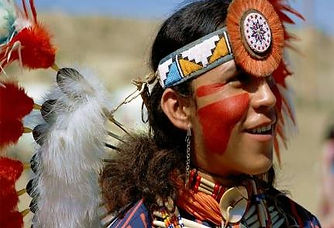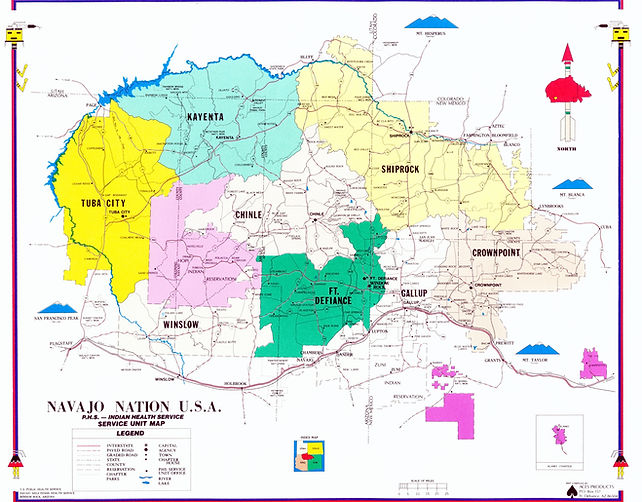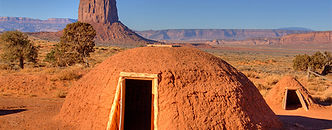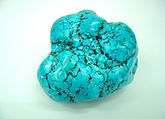
Native American Literature Anthology 2.0
Sara Downs
N. Scott Momaday
N. Scott Momaday is one of the premier poets of American literature. He grew up among the Navajo tribe and his poetry often reflects the Southwestern landscape spiritually and physically.

1
Earth and I Gave You Turquoise
Earth and I gave you turquoise
when you walked singing
We lived laughing in my house
and told old stories
You grew ill when the owl cried
We will meet on Black Mountain
I will bring corn for planting
and we will make fire
Children will come to your breast
You will heal my heart
I speak your name many times
The wild cane remembers you
My young brother's house is filled
I go there to sing
We have not spoken of you
but our songs are sad
When Moon Woman goes to you
I will follow her white way
Tonight they dance near Chinle
by the seven elms
There your loom whispered beauty
They will eat mutton
and drink coffe till morning
You and I will not be there
I saw a crow by Red Rock
standing on one leg
It was black of your hair
The years are heavy
I will ride the swiftest horse
You will hear the drumming hooves
December 29, 1890
Wounded Knee Creek
In the shine of photographs
are the slain, frozen and black
on a simple field of snow.
They image ceremony:
women and children dancing,
old men prancing, making fun.
In autumn there were songs, long
since muted in the blizzard.
In summer the wild buckwheat
shone like fox fur and quillwork,
and dusk guttered on the creek.
Now in serene attitudes
of dance, the dead in glossy
death are drawn in ancient light.
"The Earth and I Gave You Turquoise" follows the life of a man through the passing of his wife or lover. The first stanza shows the reader that life together was good. They laughed together and she liked to sing. Then she grew ill, and the owl cried signifies death. The man is still in love with his wife and when they meet on Black Mountain, he's saying that they will be reunited in the after life. Even death cannont seperate the man from his wife. The second stanza illustrates the man's grieving process. He wants to plant corn in his honor, and the tribe will come and mourn/celebrate the passing. The children will always remember her and her spirit will help heal his heart ache. However, by saying he will mention her name many times, he's summoning her spirit. He's still so full of grief, he needs her to come back, despite it's implications.
In the third stanza when he goes to his brother's house to sing, he's doing so in remembrance of his wife. He honors her by remembering her gift of song, but also helps himself grieve by keeping her close by this gift. Neither of the men speak her name because they've finally healed somewhat and don't want to summon her back. Their songs are sad, though, because they still miss her pressence on Earth. The last two lines of the third stanza tells the reader that the man is dying. He will follow the Moon Woman back to his wife: they will be reunited by death. The fourth stanza describes a scene taking place on Earth, but neither of them will be there because both have passed on. The final stanza of the poem once againd describes the man's yearning for his wife. He will ride the swiftest horse; he will get to her as soon as possible. She will hear the hooves; she will be waiting for him. They will finally be together again. The title reflects back to happiness the man brought to his wife on earth. The Navajo believe that turquoise brings good fortune and well-being. All of which the man brought to his wife while they were together.
I liked this poem by Momaday because it was different than other poems. I had to stop and read it a few times to understand everything that was going on. It was nice to see the artistic abilities of Momaday and his skill with the pen. I also like how his writing is inspired by his surroundings, but it doesn't get too stereotypical "Eco-Indian".
N. Scott Momaday wrote this peom in memory of the Wounded Knee Masacare. The photographs in the beginning give the reader a feeling of remembrance. As if Momaday were looking at pictures and was moved so deeply he needed to write to relieve some of the pain. The descripition of the "black on a simple field of snow" perfectly captures what can be seen in many photographs. The bodies of the people look black and they spot the white snow-covered ground. Then the narrator takes us to a different scene. Besides seeing what is in front of him, he pictures what life was like before the winter. He sees the women and children dancing and celebrating. He sees the men joking and having fun. The autum was full of song. Full of life.
When winter came, it brought death with it. So much changed in so little time. A horrific masacare left innocent men, women, and children dead, and a culture crippled. The narrator describes summer in a different light, just like autum. He describes the the buckwheat as "shinning like fox fur ad quillwork". The reader can picture the sun lighting up the golden fields of wheat the midst of summer. Dusk rolls in and everything is serene; peaceful, calm. It's as if the brutal act that occured in the winter happened ages ago. The act is forgotten by the white man and life goes on as normal for him. All the while the Sioux are left haunted by the memories.
I don't know if I can say I "enjoyed" this poem because that word seems a little to light for this kind of material. This poem spoke to me on a more serious level. I never knew exactly what happened at Wounded Knee. I heard it mentioned once or twice in school growing up, however, it wasn't until I read this poem and the intro to it, that I fully realized what took place. It's a sobering feeling reading this poem. I think Momaday is very successful in his use of the landscape to describe what took place. It's even more powerful that he uses the land to show that the masacare is "forgotten" by the next season. I use forgotten lightly because I know it's not forgotten, especially not to the Sioux people.
**Warning**
The images you are about to see are intense. If you are sensitive to strong material you may want to skip to the next author.







